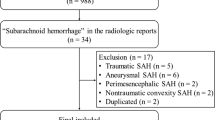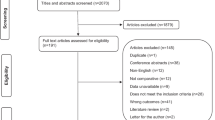Abstract
Introduction
CT angiography (CTA) is increasingly used as primary diagnostic tool to replace digital subtraction angiography (DSA) in patients with subarachnoid hemorrhage (SAH). However, 3D rotational angiography (3DRA) has substituted DSA as a reference standard. In this prospective observational study, we compare CTA with 3DRA of all cerebral vessels in a large cohort of patients with SAH.
Methods
Of 179 consecutive patients with SAH admitted between March 2013 and July 2014, 139 underwent 64- to 256-detector row CTA followed by complete cerebral 3DRA within 24 h. In 86 patients (62 %), 3DRA was performed under general anesthesia. Two observers from outside hospitals reviewed CTA data.
Results
In 118 of 139 patients (85 %), 3DRA diagnosed the cause of hemorrhage: 113 ruptured aneurysms, three arterial dissections, one micro-arteriovenous malformation (AVM), and one reversible vasoconstriction syndrome. On CTA, both observers missed all five non-aneurysmal causes of SAH. Sensitivity of CTA in depicting ruptured aneurysms was 0.88–0.91, and accuracy was 0.88–0.92. Of 113 ruptured aneurysms, 28 were ≤3 mm (25 %) and of 95 additional aneurysms, 71 were ≤3 mm (75 %). Sensitivity of depicting aneurysms ≤3 mm was 0.28–0.43. Of 95 additional aneurysms, the two raters missed 65 (68 %) and 58 (61 %). Sensitivity in detection was lower in aneurysms of the internal carotid artery than in other locations.
Conclusion
CTA had some limitations as primary diagnostic tool in patients with SAH. All non-aneurysmal causes for SAH and one in ten ruptured aneurysms were missed. Performance of CTA was poor in aneurysms ≤3 mm. The majority of additional aneurysms were not depicted on CTA.




Similar content being viewed by others
References
Byyny RL, Mower WR, Shum N et al (2008) Sensitivity of noncontrast cranial computed tomography for the emergency department diagnosis of subarachnoid hemorrhage. Ann Emerg Med 51:697–703
Westerlaan HE, van Dijk JM, Jansen-van der Weide MC et al (2011) Intracranial aneurysms in patients with subarachnoid hemorrhage: CT angiography as a primary examination tool for diagnosis-systematic review and meta-analysis. Radiology 258:134–145
van Rooij WJ, Sprengers ME, de Gast AN et al (2008) 3D rotational angiography: the new gold standard in the detection of additional intracranial aneurysms. AJNR Am J Neuroradiol 29:976–979
van Rooij WJ, Peluso JP, Sluzewski M et al (2008) Additional value of 3D rotational angiography in angiographically negative aneurysmal subarachnoid hemorrhage: how negative is negative? AJNR Am J Neuroradiol 29:962–966
Ishihara H, Kato S, Akimura T et al (2007) Angiogram-negative subarachnoid hemorrhage in the era of three dimensional rotational angiography. J Clin Neurosci 14:252–255
Chappell ET, Moure FC, Good MC (2003) Comparison of computed tomographic angiography with digital subtraction angiography in the diagnosis of cerebral aneurysms: a meta-analysis. Neurosurgery 52:624–631
Menke J, Larsen J, Kallenberg K (2011) Diagnosing cerebral aneurysms by computed tomographic angiography: meta-analysis. Ann Neurol 69:646–654
van Gelder JM (2003) Computed tomographic angiography for detecting cerebral aneurysms: implications of aneurysm size distribution for the sensitivity, specificity, and likelihood ratios. Neurosurgery 53:597–605
Lu L, Zhang LJ, Poon CS et al (2012) Digital subtraction CT angiography for detection of intracranial aneurysms: comparison with three-dimensional digital subtraction angiography. Radiology 262:605–612
Gonzalez AM, Narata AP, Yilmaz H et al (2014) Blood blister-like aneurysms: single center experience and systematic literature review. Eur J Radiol 83:197–205
Dammert S, Krings T, Moller-Hartmann W et al (2004) Detection of intracranial aneurysms with multi-slice CT: comparison with conventional angiography. Neuroradiology 46:427–434
White PM, Wardlaw JM, Easton V (2000) Can non-invasive imaging accurately depict intracranial aneurysms? A systematic review. Radiology 217:361–370
Romijn M, Gratama van Andel HA, van Walderveen MA et al (2008) Diagnostic accuracy of CT angiography with matched mask bone elimination for detection of intracranial aneurysms: comparison with digital subtraction angiography and 3D rotational angiography. Am J Neuroradiol 29:134–139
Nijjar S, Patel B, McGinn G et al (2007) Computed tomographic angiography as the primary diagnostic study in spontaneous subarachnoid hemorrhage. J Neuroimaging 17:295–299
Westerlaan HE, Gravendeel J, Fiore D et al (2007) Multislice CT angiography in the selection of patients with ruptured intracranial aneurysms suitable for clipping or coiling. Neuroradiology 49:997–1007
Colen TW, Wang LC, Ghodke BV et al (2007) Effectiveness of MDCT angiography for the detection of intracranial aneurysms in patients with nontraumatic subarachnoid hemorrhage. AJR Am J Roentgenol 189:898–903
Zhang LJ, Wu SY, Niu JB et al (2010) Dual-energy CT angiography in the evaluation of intracranial aneurysms: image quality, radiation dose, and comparison with 3D rotational digital subtraction angiography. AJR Am J Roentgenol 194:23–30
Lim LK, Dowling RJ, Yan B, Mitchell PJ (2014) Can CT angiography rule out aneurysmal subarachnoid haemorrhage in CT scan-negative subarachnoid haemorrhage patients? J Clin Neurosci 21:191–193
Kallmes DF, Layton K, Marx WF et al (2007) Death by nondiagnosis: why emergent CT angiography should not be done for patients with subarachnoid hemorrhage. AJNR Am J Neuroradiol 28:1837–1838
Pradilla G, Wicks RT, Hadelsberg U et al (2013) Accuracy of computed tomography angiography in the diagnosis of intracranial aneurysms. World Neurosurg 80:845–852
Moran CJ (2011) Aneurysmal subarachnoid hemorrhage: DSA versus CT angiography—is the answer available? Radiology 258:15–17
Ethical standards and patient consent
We declare that all human and animal studies have been approved by the Institutional Review Board and have therefore been performed in accordance with the ethical standards laid down in the 1964 Declaration of Helsinki and its later amendments. We declare that all patients gave informed consent prior to inclusion in this study
Conflict of interest
We declare we have no conflict of interest.
Author information
Authors and Affiliations
Corresponding author
Rights and permissions
About this article
Cite this article
Bechan, R.S., van Rooij, S.B., Sprengers, M.E. et al. CT angiography versus 3D rotational angiography in patients with subarachnoid hemorrhage. Neuroradiology 57, 1239–1246 (2015). https://doi.org/10.1007/s00234-015-1590-9
Received:
Accepted:
Published:
Issue Date:
DOI: https://doi.org/10.1007/s00234-015-1590-9




